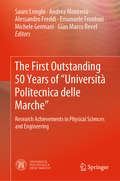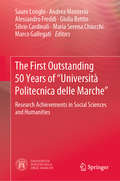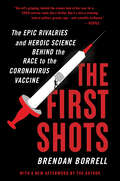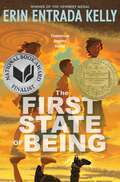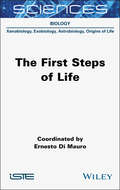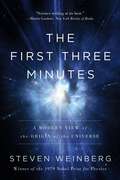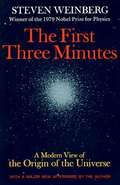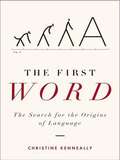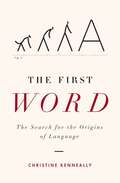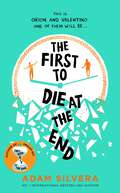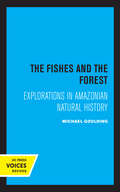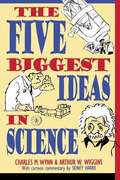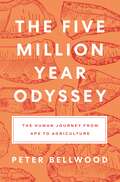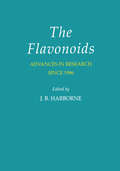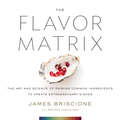- Table View
- List View
The First Outstanding 50 Years of “Università Politecnica delle Marche”: Research Achievements in Life Sciences
by Sauro Longhi Mario Giordano Andrea Monteriù Alessandro Freddi Lucia Aquilanti Maria Gabriella Ceravolo Oliana Carnevali Gianluca MoronciniThe book describes the significant multidisciplinary research findings at the Università Politecnica delle Marche and the expected future advances. It addresses some of the most dramatic challenges posed by today’s fast-growing, global society and the changes it has caused. It also discusses solutions to improve the wellbeing of human beings. The book covers the main research achievements in the various disciplines of the life sciences, and includes chapters that highlight mechanisms relevant to all aspects of human diseases, the molecular, cellular, and functional basis of therapy, and its translation into the management of people’s health needs. It also describes research on traditional and innovative foods to enhance quality, safety and functionality, and to develop bioactive/nutraceutical compounds. Further chapters address conservation and management of various environments, from the forests to the oceans, describing the studies on countermeasures against climate changes and terrestrial/aquatic pollutants, and on terrestrial/marine biodiversity, ecosystems and landscapes, erosion of genetic biodiversity, innovative aquaculture feed, sustainable crop production and management of forests. Lastly, the book reports the findings of research work on different classes of biomolecules, and on the molecular basis of antibiotic resistances and their diffusion.
The First Outstanding 50 Years of “Università Politecnica delle Marche”: Research Achievements in Physical Sciences and Engineering
by Sauro Longhi Michele Germani Andrea Monteriù Alessandro Freddi Emanuele Frontoni Gian Marco RevelThe book describes the significant multidisciplinary research findings at the Università Politecnica delle Marche and the expected future advances. It addresses some of the most dramatic challenges posed by today’s fast-growing, global society and the changes it has caused. It also discusses solutions to improve the wellbeing of human beings. The book covers the main research achievements in the different disciplines of the physical sciences and engineering, as well as several research lines developed at the university’s Faculty of Engineering in the fields of electronic and information engineering, telecommunications, biomedical engineering, mechanical engineering, manufacturing technologies, energy, advanced materials, chemistry, physics of matter, mathematical sciences, geotechnical engineering, circular economy, urban planning, construction engineering, infrastructures and environment protection, technologies and digitization of the built environment and cultural heritage. It highlights the international relevance and multidisciplinarity of research at the university as well as the planned research lines for the next years.
The First Outstanding 50 Years of “Università Politecnica delle Marche”: Research Achievements in Social Sciences and Humanities
by Sauro Longhi Marco Gallegati Andrea Monteriù Alessandro Freddi Giulia Bettin Silvio Cardinali Maria Serena ChiucchiThe book describes significant multidisciplinary research findings at the Università Politecnica delle Marche and the expected future advances. It addresses some of the most dramatic challenges posed by today’s fast-growing, global society and the changes it has caused, while also discussing solutions to improve the wellbeing of human beings. The book covers the main research achievements made in the social sciences and humanities, and includes chapters that focus on understanding mechanisms that are relevant to all aspects of economic and social interactions among individuals. In line with Giorgio Fuà’s contribution, the interdisciplinary research being pursued at the Faculty of Economics of Università Politecnica delle Marche is aimed at interpreting the process of economic development in all of its facets, both at the national and local level, with a particular focus on profit and non-profit organizations. Various disciplines are covered, from economics to sociology, history, statistics, mathematics, law, accounting, finance and management.
The First Shots: The Epic Rivalries and Heroic Science Behind the Race to the Coronavirus Vaccine
by Brendan BorrellThe full inside story of the high-stakes, global race for the lifesaving vaccine to end the pandemic Heroic science. Chaotic politics. Billionaire entrepreneurs. Award-winning journalist Brendan Borrell brings the defining story of our times alive through compulsively readable, first-time reporting on the players leading the fight against a vicious virus. The First Shots, soon to be the subject of an HBO limited series with superstar director and producer Adam McKay (Succession, Vice, The Big Short), draws on exclusive, high-level access to weave together the intense vaccine-race conflicts among hard-driving, heroic scientists and the epic rivalries among Washington power players that shaped 18 months of fear, resolve, and triumph. From infectious disease expert Michael Callahan, an American doctor secretly on the ground in Wuhan in January 2020 to gauge the terrifying ravages of Disease X; to Robert (Dr. Bob) Kadlec, one of Operation Warp Speed&’s architects, whose audacious plans for the American people run straight into the buzz saw of the Trump White House factions; to Stéphane Bancel of upstart Moderna Therapeutics going toe-to-toe with pharma behemoth Pfizer, The First Shots lays bare, in a way we have not seen, the full stunning story behind the medical science &“moon shot&” of our lifetimes.
The First State of Being
by Erin Entrada KellyWINNER OF THE NEWBERY MEDALA FINALIST FOR THE 2024 NATIONAL BOOK AWARDA NEW YORK TIMES BESTSELLER INDIE BESTSELLERChicago Public Library Best Fiction for Older Readers of 2024Shelf Awareness Best Books of 2024 for Kids and TeensBookPage Best Middle Grade of 2024Common Sense Media Best Books of 20242025 Excellence in Children’s and Young Adult Science Fiction Notable ListWhen twelve-year-old Michael Rosario meets a mysterious boy from the future, his life is changed forever. From bestselling author Erin Entrada Kelly, also the winner of the Newbery Medal for Hello, Universe and a Newbery Honor for We Dream of Space, this novel explores themes of family, friendship, trust, and forgiveness. The First State of Being is for fans of Rebecca Stead’s When You Reach Me.It's August 1999. For twelve-year-old Michael Rosario, life at Fox Run Apartments in Red Knot, Delaware, is as ordinary as ever—except for the looming Y2K crisis and his overwhelming crush on his sixteen-year-old babysitter, Gibby. But when a disoriented teenage boy named Ridge appears out of nowhere, Michael discovers there is more to life than stockpiling supplies and pining over Gibby.It turns out that Ridge is carefree, confident, and bold, things Michael wishes he could be. Unlike Michael, however, Ridge isn’t where he belongs. When Ridge reveals that he’s the world’s first time traveler, Michael and Gibby are stunned but curious. As Ridge immerses himself in 1999—fascinated by microwaves, basketballs, and malls—Michael discovers that his new friend has a book that outlines the events of the next twenty years, and his curiosity morphs into something else: focused determination. Michael wants—no, needs—to get his hands on that book. How else can he prepare for the future? But how far is he willing to go to get it?A story of time travel, friendship, found family, and first loves, this thematically rich novel is distinguished by its voice, character development, setting, and exploration of the issues that resonate with middle grade readers.Finalist for the National Book Award and Winner of the Newbery Medal.
The First Steps of Life
by Ernesto Di MauroOrigin of Life studies have a nearly-impossible goal: understanding nature through the comprehension of its origins and its complexities. As a growing field with poorly-defined borders, Origin of Life studies profit from progress in other disciplines. This book proposes both an overview of this large area and an in-depth look at the opinions and results obtained by some of the active contributors of this fascinating and deeply thought-provoking matter. The topics are presented in a bottom-up order, first touching on the habitability of the universe, then the rationale behind meaningful prebiotic chemistry, the possible or probable prebiotic chemical frames, the problem of chirality, and moving on through the role of minerals in biogenesis, biogenic fertile environments, the in-and-out problem as solved by vesicles physics, the evolution of the codes, the structure of LUCA and its proto metabolisms and the meaning of complex extant biological biomorphs, as exemplified by viroids. These topics and the reasoning within the chapters are provided against the backdrop of the evolution of information and complexity.
The First Three Minutes: A Modern View Of The Origin Of The Universe
by Steven WeinbergA Nobel Prize-winning physicist explains what happened at the very beginning of the universe, and how we know, in this popular science classic. Our universe has been growing for nearly 14 billion years. But almost everything about it, from the elements that forged stars, planets, and lifeforms, to the fundamental forces of physics, can be traced back to what happened in just the first three minutes of its existence.In this book, Nobel Laureate Steven Weinberg describes in wonderful detail what happened in these first three minutes. It is an exhilarating journey that begins with the Planck Epoch - the earliest period of time in the history of the universe - and goes through Einstein's Theory of Relativity, the Hubble Red Shift, and the detection of the Cosmic Microwave Background. These incredible discoveries all form the foundation for what we now understand as the "standard model" of the origin of the universe. The First Three Minutes examines not only what this model looks like, but also tells the exciting story of the bold thinkers who put it together. Clearly and accessibly written, The First Three Minutes is a modern-day classic, an unsurpassed explanation of where it is that everything really comes from.
The First Three Minutes: A Modern View of The Origin of the Universe
by Steven WeinbergThis book is concerned with the early universe, and in particular with the new understanding of the early universe that has grown out of the discovery of the cosmic microwave radiation background in 1965.
The First Woman Doctor
by Rachel BakerIn 1847, there were no women doctors. Elizabeth Blackwell was however, determined to become the first woman doctor, no matter what everyone else told her.
The First Word
by Christine KenneallyAn accessible exploration of a burgeoning new field: the incredible evolution of language The first popular book to recount the exciting, very recent developments in tracing the origins of language, The First Word is at the forefront of a controversial, compelling new field. Acclaimed science writer Christine Kenneally explains how a relatively small group of scientists that include Noam Chomsky and Steven Pinker assembled the astounding narrative of how the fundamental process of evolution produced a linguistic ape?in other words, us. Infused with the wonder of discovery, this vital and engrossing book offers us all a better understanding of the story of humankind. .
The First Word: The Search for the Origins of Language
by Christine KenneallyThis is about the quest for the origins of human language, in two sections. The first explains how language developed and the processes of evolution. The second tells why scientists are at last able to explore the subject.
The First to Die at the End: The prequel to the international No. 1 bestseller THEY BOTH DIE AT THE END!
by Adam SilveraIn this prequel to the NO. 1 INTERNATIONAL BESTSELLING phenomenon of TIKTOK fame, They Both Die at the End, two new strangers spend a life-changing day together after Death-Cast make their first fateful calls. '[A] heart-pounding story [full] of emotion and suspense.' Kirkus 'An extraordinary book with a riveting plot.' BooklistMeet Orion and Valentino. It&’s the night before Death-Cast goes live, and there&’s one question on everyone&’s mind: Can Death-Cast actually predict death, or is it an elaborate hoax? Orion Pagan has waited years for someone to tell him that he&’s going to die, given his serious heart condition. Valentino Prince has a long and promising future ahead of him and only registered for Death-Cast after his twin sister nearly died in a car accident. Orion and Valentino cross paths in Times Square and immediately feel a deep connection. But when the first End Day calls go out, their lives are changed for ever – one of them receives a call . . . the other doesn&’t. Told with acclaimed author Adam Silvera&’s signature bittersweet touch, this story celebrates the lasting impact that people have on each other and proves that life is always worth living to the fullest. PRAISE FOR ADAM SILVERA: 'There isn't a teenager alive who won't find their heart described perfectly on these pages.' Patrick Ness, author of The Knife of Never Letting Go 'Adam Silvera is a master at capturing the infinite small heartbreaks of love and loss and grief.' Nicola Yoon, author of Everything, Everything 'A phenomenal talent.' Juno Dawson, author of Clean and Wonderland 'Bold and haunting.' Lauren Oliver, author of Delirium
The Fish Production Potential of the Baltic Sea
by Andreas C. Bryhn Lars Håkanson Henrik Ragnarsson StaboIt presents a new approach to set fish quota based on holistic ecosystem modeling (the CoastWeb-model) and also a plan to optimize a sustainable management of the Baltic Sea including a cost-benefit analysis. This plan accounts for the production of prey and predatory fish under different environmental conditions, professional fishing, recreational fishing and fish cage farm production plus an analysis of associated economic values. Several scenarios and remedial strategies for Baltic Sea management are discussed and an "optimal" strategy motivated and presented, which challenges the HELCOM strategy that was accepted by the Baltic States in November 2007. The strategy advocated in this book would create more than 7000 new jobs, the total value of the fish production would be about 1600 million euro per year plus 1000 million euro per year related to the willingness-to-pay to combat the present conditions in the Baltic Sea. Our strategy would cost about 370 million euro whereas the HELCOM strategy would cost about 3100 million euro per year. The "optimal" strategy is based on a defined goal - that the water clarity in the Gulf of Finland should return to what it was 100 years ago.
The Fisherman's Ocean: How Marine Science Can Help You Find and Catch More Fish
by David A Ross PhDThis volume &“clearly explains how marine science can help saltwater anglers catch more and bigger fish . . . comprehensive yet accessible&” (Booklist). Here at last, in layman&’s terms, is a fisherman's guide to the habitat and behavior of saltwater fish. The author, an oceanographer and avid fly fisherman, explains the marine environment and the factors that affect where game fish congregate—everything from how they move with tides and currents to what they see, smell, taste, and hear. The copiously illustrated text covers inshore and offshore habitat and will prove invaluable to anyone who fishes in saltwater, whether in the surf, on the flats, or out at sea. The ocean is vast. It pays to be educated.
The Fishes and the Forest: Explorations in Amazonian Natural History
by Michael GouldingThis title is part of UC Press's Voices Revived program, which commemorates University of California Press’s mission to seek out and cultivate the brightest minds and give them voice, reach, and impact. Drawing on a backlist dating to 1893, Voices Revived makes high-quality, peer-reviewed scholarship accessible once again using print-on-demand technology. This title was originally published in 1980.
The Five Ages of the Universe: Inside the Physics of Eternity
by Fred C. Adams Greg LaughlinA Simon & Schuster eBook. Simon & Schuster has a great book for every reader.
The Five Biggest Ideas in Science
by Charles M. Wynn Arthur W. WigginsThe five major ideas that have revolutionized history and human perceptions are elaborately described with many simple illustrations and cartoons.
The Five Habits of Highly Effective Honeybees: From Honeybee Democracy (Princeton Shorts #5)
by Thomas D. SeeleyStudies of animal behavior have often been invoked to help explain and even guide human behavior. Think of Pavlov and his dogs or Goodall and her chimps. But, as these examples indicate, the tendency has been to focus on "higher," more cognitively developed, and thus, it is thought, more intelligent creatures than mindless, robotic insects. Not so! Learn here how honeybees work together to form a collective intelligence and even how they make decisions democratically. The wizzzzdom of crowds indeed! Here are five habits of effective groups that we can learn from these clever honeybees. Princeton Shorts are brief selections excerpted from influential Princeton University Press publications produced exclusively in eBook format. They are selected with the firm belief that while the original work remains an important and enduring product, sometimes we can all benefit from a quick take on a topic worthy of a longer book. In a world where every second counts, how better to stay up-to speed on current events and digest the kernels of wisdom found in the great works of the past? Princeton Shorts enables you to be an instant expert in a world where information is everywhere but quality is at a premium. The Five Habits of Highly Effective Honeybees (and What We Can Learn from Them) does just that.
The Five Impossible Tasks of Eden Smith
by Tom LlewellynChallenged by a secret society of metalworkers, Eden must do all she can to save the only family she has left in this fantasy adventure.When Eden Smith moves into the beautiful and bizarre old mansion housing her grandfather, she discovers a strange society of elderly metalworkers whose mastery verges on the magical. Deadly mechanical birds, a cavernous chamber full of dirty dishes, a highly dangerous game of Machinist BINGO–life at the guild is not only strange, it&’s also dangerous.Eden&’s grandfather, Vulcan Smith, the most gifted of all the metalsmiths in the mansion, has just been sentenced to live out the rest of his days locked in a tiny basement room for rebelling against the guild. To save him, Eden will have to complete The Five Impossible Tasks, a series of deadly feats that have already killed off many of Eden and Vulcan&’s ancestors. With the help of her new friend Nathaniel and a cast of eccentric old silversmiths, blacksmiths, and inventive machinists, Eden sets out to do the impossible before her newfound grandfather is lost to her forever.In The Five Impossible Tasks of Eden Smith, Tom Llewellyn has crafted a wholly original world of wild contraptions, roguish characters, and perilous feats perfect for fans of Karuna Riazi, Laura Ruby, and Lemony Snicket.
The Five Senses
by Leslee LazarA fascinating introduction to how our senses work. In this well-researched book, how the human and animal sense organs function is scientifically and logically explained.
The Five Senses: Touch, Smell, Taste, Hearing And Vision (Jan De Vries Healthcare Ser.)
by Jan de VriesBest-selling author and world-renowned naturopath Jan de Vries has become increasingly aware of the damage that today's environment has had on the five senses of touch, smell, taste, hearing and vision. Man's immune system is under constant attack by viruses, allergies, bacteria, pollution, food, water and air. As Jan de Vries says in his introduction, 'If you lose your senses you lose your sense of living'; this book will help you to live again.
The Five-Million-Year Odyssey: The Human Journey from Ape to Agriculture
by Peter BellwoodThe epic story of human evolution, from our primate beginnings more than five million years ago to the agricultural eraOver the course of five million years, our primate ancestors evolved from a modest population of sub-Saharan apes into the globally dominant species Homo sapiens. Along the way, humans became incredibly diverse in appearance, language, and culture. How did all of this happen? In The Five-Million-Year Odyssey, Peter Bellwood synthesizes research from archaeology, biology, anthropology, and linguistics to immerse us in the saga of human evolution, from the earliest traces of our hominin forebears in Africa, through waves of human expansion across the continents, and to the rise of agriculture and explosive demographic growth around the world.Bellwood presents our modern diversity as a product of both evolution, which led to the emergence of the genus Homo approximately 2.5 million years ago, and migration, which carried humans into new environments. He introduces us to the ancient hominins—including the australopithecines, Homo erectus, the Neanderthals, and others—before turning to the appearance of Homo sapiens circa 300,000 years ago and subsequent human movement into Eurasia, Australia, and the Americas. Bellwood then explores the invention of agriculture, which enabled farmers to disperse to new territories over the last 10,000 years, facilitating the spread of language families and cultural practices. The outcome is now apparent in our vast array of contemporary ethnicities, linguistic systems, and customs.The fascinating origin story of our varied human existence, The Five-Million-Year Odyssey underscores the importance of recognizing our shared genetic heritage to appreciate what makes us so diverse.
The Flaming Mountain (Rick Brant, # #17)
by John BlaineRick, Scotty, and others from the Spindrift Science Lab go to a small island near the equator to help deal with a volcano that's ready to blow.
The Flavonoids Advances in Research Since 1986: Advances In Research Since 1980
by J.B. HarborneFlavonoids are a group of natural products isolated from a wide variety of plants, and are responsible for much of the coloring found in vascular plants. They exhibit a wide range of biological activities and are of particular interest as potential anti-cancer agents, as insect antifeedants, and as natural insecticides. The Flavonoids: Advances in Research Since 1986 is a self-contained account of this important group of plant products.
The Flavor Matrix: The Art and Science of Pairing Common Ingredients to Create Extraordinary Dishes
by Brooke Parkhurst James BriscioneA revolutionary new guide to pairing ingredients, based on a famous chef's groundbreaking research into the chemical basis of flavorAs an instructor at one of the world’s top culinary schools, James Briscione thought he knew how to mix and match ingredients. Then he met IBM Watson. Working with the supercomputer to turn big data into delicious recipes, Briscione realized that he (like most chefs) knew next to nothing about why different foods taste good together. That epiphany launched him on a quest to understand the molecular basis of flavor—and it led, in time, to The Flavor Matrix. A groundbreaking ingredient-pairing guide, The Flavor Matrix shows how science can unlock unheard-of possibilities for combining foods into astonishingly inventive dishes. Briscione distills chemical analyses of different ingredients into easy-to-use infographics, and presents mind-blowing recipes that he's created with them. The result of intensive research and incredible creativity in the kitchen, The Flavor Matrix is a must-have for home cooks and professional chefs alike: the only flavor-pairing manual anyone will ever need.

